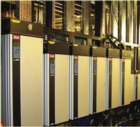BMSs meet variable-speed drives

The application of variable speed drives with all fans and pumps in the refurbished plant room of the Natural History Museum uses Danfoss drives and eliminates the need for balancing and commissioning valves.
Modern variable-speed drives can become an integral part of a building-management system — and eliminate the need for motor control panels. John Reid describes the realities.Motor control panels, once the very heartbeat of any controls system, have become all but redundant in today’s installations — a casualty in the drive for more localised control of plant. Their position in the scheme of things has been substantially reduced by the increasing use of variable-speed drives, items that always have been an important piece of equipment within a system, but now, with built in intelligence, they are playing a key role in the latest advance in controls installation. All the more recent major installations we have undertaken at ICS (Unilever House, Bow Bells, 201 Bishopsgate and Broadgate Tower) are not reliant on motor control panels, as they would have been just a couple of years ago, but are reaping the benefits of intelligent variable-speed drives and the virtual control they bring. Variable-speed drives have become an integral part of the building-management system, connected through a BACnet link as an extension of the system – another node in the same manner as outstations. They have been equipped with keypads to enable interrogation of equipment they are controlling — all without the need for a motor-control panel. We just do not need motor control-panels any more. The switchgear normally controlling the operation of the plant is now replaced by the variable-speed drive or is provided in a packaged piece of equipment that has been delivered to site with its own controls built in.
 |
This installation at Manchester United Football Club uses ABB drives to control the fans for the air conditioning system serving the two buildings that comprise the stadium’s Quadrant expansion project. |
The system installed at Unilever House recognised all these benefits, although there was a requirement to maintain some of the functionality such a over-ride switches and visual identification of plant operating status normally built into motor-control panels Nevertheless, the £1.3 million installation did make extensive use of local distribution boards serving the plant and localised outstations through variable-speed drives. We installed more than 800 fan-coil units with 28 different control configurations to meet the special requirements brought about by the nature of the use of specific areas of the 325 000 m2 Grade 2 listed building. The control packages embraced a number of different sensor options, including heating and cooling provided by low-pressure hot water and chilled water, or combinations of chilled water and electric heating, and, in some instances, heating or cooling only. They also offered conventional control of return air, room control with high quality LCD user displays and interface with PIRs to activate services only when rooms are occupied. At the subsequent projects at Bow Bells and Broadgate, it was agreed that as the variable-speed drives are connected to the BMS at high level the operational functionality could be viewed through the BMS; manual over-ride and interrogation could be undertaken through the integral key pads on the variable -speed drives. This slightly different approach means the variable speed drive is effectively just another outstation node with its own I/O capability enabling us to view plant status through the feedback to the variable speed drive, undertake start and stop operations and over-ride functions — we can be so much more expansive.
 |
Recent projects using variable-speed drives to eliminate the need for motor control panels are 210 Bishopsgate and the Broadgate Tower. |
In the past, before today’s levels of integration were available, connection directly to the variable-speed drive would not have been feasible, as information on plant operation would not have been available. Now, with high-level interface capabilities and incorporation of inputs and outputs into the programmable variable-speed drives, we are able to feed BMS equipment data directly and seamlessly use all the additional functionality that has been made available. Most importantly, the critical safety logic remains uncompromised. As an example, any attempt to manually invoke operation of an AHU fan would be met with a signal from the variable-speed drive to automatically open the associated damper. The fan would not begin operation until the feedback signals proved the damper was open. Locally sited distribution boards with their associated variable-speed drives are more cost effective to install than motor control panels as they comprise mainly off-the-shelf parts, so eliminating the need to design bespoke panels which, as we all know, were beginning to take up increasingly large amounts of precious space in plant rooms. They make better use of the equipment and offer substantially more information through the high-level integration. They are robust and, because the switchgear is being located close to the plant, cable runs are dramatically shortened. All-in-all, the move to add intelligence to variable-speed drives has been a significant step forward, leading to more cost effective and efficient localised control of plant. John Reid is managing director of Integrated Control Systems.
Related links:










